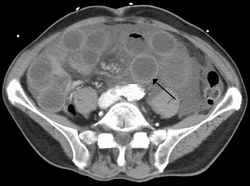Abdominal angina
Editor-In-Chief: Prab R Tumpati, MD
Obesity, Sleep & Internal medicine
Founder, WikiMD Wellnesspedia &
W8MD medical weight loss NYC and sleep center NYC
| Abdominal angina | |
|---|---|

| |
| Synonyms | Intestinal angina |
| Pronounce | N/A |
| Specialty | N/A |
| Symptoms | Abdominal pain, weight loss, nausea, vomiting |
| Complications | Bowel infarction, sepsis |
| Onset | After eating |
| Duration | Chronic |
| Types | N/A |
| Causes | Atherosclerosis of the mesenteric arteries |
| Risks | Smoking, hypertension, hyperlipidemia, diabetes mellitus |
| Diagnosis | CT angiography, Doppler ultrasound, MRA |
| Differential diagnosis | Peptic ulcer disease, gallstones, pancreatitis |
| Prevention | N/A |
| Treatment | Revascularization, angioplasty, bypass surgery |
| Medication | Antiplatelet drugs, statins, vasodilators |
| Prognosis | N/A |
| Frequency | Rare |
| Deaths | Can be fatal if untreated |
Chest and abdominal pain are the most common reasons that persons aged 15 years and over visit the emergency department. Abdominal angina, like the cardiac angina, is due to ischemia of the mesenteric arteries.
Other names
- Mesenteric vascular disease
- Ischemic colitis; Ischemic bowel - mesenteric
- Atherosclerosis - mesenteric artery
Cause
Mesenteric artery ischemia occurs when there is a narrowing or blockage of one or more of the three major arteries that supply the small and large intestines. These are called the mesenteric arteries.
History and physical examination
Midepigastric or central abdominal pain within 10–15 minutes after eating in history. Also ask for smoking history, family history, and any history of other vascular disease such as coronary artery disease and or peripheral vascular disease.
Physical examination
The abdomen typically is scaphoid and soft, even during an episode of pain.
Other signs
Patients present with stigmata of weight loss and signs of peripheral vascular disease, particularly aortoiliac occlusive disease, may be present.
Risk factors
- Smoking is an associated risk factor.
- In most series, approximately 75–80% of patients smoke.
Pathophysiology
The underlying vascular pathophysiology is similar to that seen in angina pectoris and intermittent claudication with atherosclerosis.
Mesenteric vessel atherosclerosis
The most common cause of abdominal angina is atherosclerotic vascular disease, where the occlusive process commonly involves the ostia and the proximal few centimeters of the mesenteric vessels. It can be associated with:
Epidemiology
- Internationally: Extremely rare. True incidence is unknown
- Race: No data available
- Sex: Females outnumber males by approximately 3 to 1
- Age: Mean age of affected individuals is slightly older than 60 years
Diagnosis
It is diagnosed with a combination of clinical history characterized by abdominal pain within 15-20 minutes of eating, and other studies such as the following:
- A Doppler ultrasound or CT angiogram scan may show problems with the blood vessels and the intestine.
- A mesenteric angiogram is a test that involves injecting a special dye into your bloodstream to highlight the arteries of the intestine.
- Then x-rays are taken of the area. This can show the location of the blockage in the artery.
Treatment
Vascular stents have been used in the treatment of abdominal angina.
See also
| Health science - Medicine - Gastroenterology - edit |
|---|
| Diseases of the esophagus - stomach |
| Halitosis | Nausea | Vomiting | GERD | Achalasia | Esophageal cancer | Esophageal varices | Peptic ulcer | Abdominal pain | Stomach cancer | Functional dyspepsia | Gastroparesis |
| Diseases of the liver - pancreas - gallbladder - biliary tree |
| Hepatitis | Cirrhosis | NASH | PBC | PSC | Budd-Chiari | Hepatocellular carcinoma | Acute pancreatitis | Chronic pancreatitis | Pancreatic cancer | Gallstones | Cholecystitis |
| Diseases of the small intestine |
| Peptic ulcer | Intussusception | Malabsorption (e.g. Coeliac, lactose intolerance, fructose malabsorption, Whipple's) | Lymphoma |
| Diseases of the colon |
| Diarrhea | Appendicitis | Diverticulitis | Diverticulosis | IBD (Crohn's, Ulcerative colitis) | IBS | Constipation | Colorectal cancer | Hirschsprung's | Pseudomembranous colitis |
Transform your life with W8MD's budget GLP-1 injections from $125.
W8MD offers a medical weight loss program to lose weight in Philadelphia. Our physician-supervised medical weight loss provides:
- Most insurances accepted or discounted self-pay rates. We will obtain insurance prior authorizations if needed.
- Generic GLP1 weight loss injections from $125 for the starting dose.
- Also offer prescription weight loss medications including Phentermine, Qsymia, Diethylpropion, Contrave etc.
NYC weight loss doctor appointments
Start your NYC weight loss journey today at our NYC medical weight loss and Philadelphia medical weight loss clinics.
- Call 718-946-5500 to lose weight in NYC or for medical weight loss in Philadelphia 215-676-2334.
- Tags:NYC medical weight loss, Philadelphia lose weight Zepbound NYC, Budget GLP1 weight loss injections, Wegovy Philadelphia, Wegovy NYC, Philadelphia medical weight loss, Brookly weight loss and Wegovy NYC
|
WikiMD's Wellness Encyclopedia |
| Let Food Be Thy Medicine Medicine Thy Food - Hippocrates |
Medical Disclaimer: WikiMD is not a substitute for professional medical advice. The information on WikiMD is provided as an information resource only, may be incorrect, outdated or misleading, and is not to be used or relied on for any diagnostic or treatment purposes. Please consult your health care provider before making any healthcare decisions or for guidance about a specific medical condition. WikiMD expressly disclaims responsibility, and shall have no liability, for any damages, loss, injury, or liability whatsoever suffered as a result of your reliance on the information contained in this site. By visiting this site you agree to the foregoing terms and conditions, which may from time to time be changed or supplemented by WikiMD. If you do not agree to the foregoing terms and conditions, you should not enter or use this site. See full disclaimer.
Credits:Most images are courtesy of Wikimedia commons, and templates, categories Wikipedia, licensed under CC BY SA or similar.
Contributors: Prab R. Tumpati, MD



